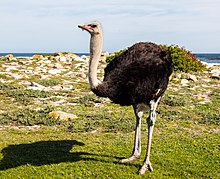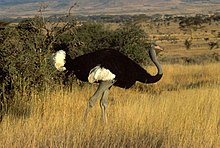Struthionidae
| Struthionidae | |
|---|---|

| |
| Struthio camelus australis at the Cape of Good Hope, South Africa | |
| Scientific classification | |
| Domain: | Eukaryota |
| Kingdom: | Animalia |
| Phylum: | Chordata |
| Class: | Aves |
| Infraclass: | Palaeognathae |
| Order: | Struthioniformes Latham, 1790 |
| Family: | Struthionidae Vigors, 1825[1] |
| Type genus | |
Struthio
, 1758 | |
| Genera | |
| |
| Synonyms[2] | |
| |
Struthionidae (
The first species of Struthio appear during the Miocene epoch, though various Paleocene, Eocene, and Oligocene fossils may also belong to the family.[4][5] Ostriches are classified in the ratite group of birds, all extant species of which are flightless, including the kiwis, emus, and rheas. Traditionally, the order Struthioniformes contained all the ratites. However, recent genetic analysis has found that the group is not monophyletic, as it is paraphyletic with respect to the tinamous, so the ostriches are usually classified as the only members of the order,[6][7] though the IUCN uses a broader classification and includes all "ratites" and tinamous in Struthioniformes.[8]
Evolution
Struthionidae is a member of the

While the relationship of the African fossil species is comparatively straightforward, many Asian species of ostriches have been described from fragmentary remains, and their interrelationships and how they relate to the African ostriches are confusing. In
Distribution and habitat

Today ostriches are only found natively in the wild in
Taxonomy

In 2019, the species S. pannonicus, S. dmanisensis (the giant ostrich), and S. transcaucasicus were transferred to the genus Pachystruthio.[18]
Order Struthioniformes Latham 1790 (ostriches)
- Family Struthionidae Vigors 1825
- Genus †Pachystruthio (Kretzoi 1954) (Late Pliocene – Pleistocene)
- Genus StruthioLinnaeus 1758 (Early Miocene – Recent)
See also
References
- ^ Vigors, Nicholas Aylward (1825). "Observations on the natural affinities that connect the orders and families of birds". Transactions of the Linnean Society of London. 14 (3): 395-517 [483].
- ISBN 80-901105-3-8.)
{{cite book}}: CS1 maint: ignored ISBN errors (link - S2CID 198384367.
- ^ Buffetaut, E.; Angst, D. (November 2014). "Stratigraphic distribution of large flightless birds in the Palaeogene of Europe and its palaeobiological and palaeogeographical implications". Earth-Science Reviews. 138: 394–408. doi:10.1016/j.earscirev.2014.07.001.
- ^ Agnolin et al, Unexpected diversity of ratites (Aves, Palaeognathae) in the early Cenozoic of South America: palaeobiogeographical implications Article in Alcheringa An Australasian Journal of Palaeontology · July 2016 DOI: 10.1080/03115518.2016.1184898
- ^ Hackett, S.J. et al. (2008) A Phylogenomic Study of Birds Reveals Their Evolutionary History. Science, 320, 1763.
- ^ Yuri, T. (2013) Parsimony and model-based analyses of indels in avian nuclear genes reveal congruent and incongruent phylogenetic signals. Biology, 2:419–44.
- ^ "The IUCN Red List of Threatened Species". IUCN Red List of Threatened Species. Retrieved 2020-04-10.
- ISSN 0004-8038.
- ISSN 1424-2818.
- ^ Doar, B.G. (2007) "Genitalia, Totems and Painted Pottery: New Ceramic Discoveries in Gansu and Surrounding Areas". China Heritage Quarterly
- .
- ^ Andersson, J. G. (1923). "Essays on the cenozoic of northern China". Memoirs of the Geological Survey of China (Peking), Series A. 3: 1–152 (53–77).
- ^ Donegan, Keenan (2002). "Struthio camelus". Animal Diversity Web. University of Michigan Museum of Zoology.
- JSTOR 4088425.
- ^ Rinat, Zafrir (25 December 2007). "The Bitter Fate of Ostriches in the Wild". Haaretz. Tel Aviv. Retrieved 10 January 2017.
- ^ Ostriches in Australia – and near my home. trevorsbirding.com (13 September 2007)
- S2CID 198384367.
